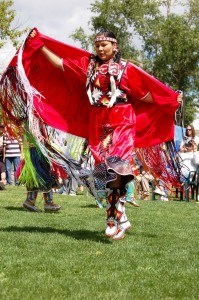
Roberta Kakinoosit takes great pride in her Aboriginal heritage. Events like the National Aboriginal Day celebration held on June 21 at the Jasper Park Information Centre give her the opportunity to show off that pride, and more importantly, to share her culture with others.
Initiated in 1996 by then-Governor General Romeo LeBlanc, Aboriginal Day was created by the Assembly of First Nations as a day to unite and celebrate indigenous cultures. In Jasper the event is organized by Parks Canada and included drumming, singing, storytelling, dancing, arts and cultural exhibits, as well as Metis jigging and traditional hand games. This years’ theme was ‘All My Relations.’
“I think days like this are a big part of breaking down the stereotype that First Nations people are all bums, druggies, prostitutes or alcoholics. There’s way more to us. And a lot of us are just learning that for ourselves,” said Kakinoosit.
But it hasn’t been easy.
“In some areas our culture seems to have dissipated,”she noted.
“What we need to do now is to pass on what we learn to our youth so we don’t lose our culture altogether.”
This is an issue that strikes home for Kakinoosit. For the past four months the Cree First Nation pow wow dancer has devoted herself to teaching First Nations youth about their culture through dance.
She says learning Aboriginal dancing helps her feel more connected to find roots and hopes it will help her students as well.
Raised on the Sucker Creek First Nation reserve, Kakinoosit grew up in what she refers to as a “cultural limbo.” Her parents, along with many of her family members, were victims of the abuse that occurred within the residential school system.
Kakinoosit said most of her relatives are still healing from the effects of their time in that system and the ongoing impact resulted in a loss of cultural identity.
“They couldn’t speak their own language or practice any of their traditions so they lost it. Growing up we didn’t know much about our heritage and were taught to follow the Christian Church, which isn’t necessarily a bad thing. But it ended up with us not really having an identity.” she explained.
“I ended up getting into drugs. I moved around a lot-Vancouver, Calgary, Edmonton. I was on my way to becoming that stereotype. And then I realized I didn’t want that life.”
Kakinoosit began studying Aboriginal dance as a way to get her life back on track, and decided to return home to Sucker Creek to share what she had learned with her family.
“Whatever culture and traditions we had upheld on our reserve were almost gone by the time I came back. So I decided to start a dance class and form a troupe so I could offer what I learned to anyone who was interested.”
More than 40 people attended Kakinoosit’s first lesson. Currently there are 22 students enrolled, many of whom accompanied her to Jasper’s Aboriginal Day celebration on Saturday.
Kakinoosit said the outpouring of support from her community has inspired several of her students, many of whom are children, to study the stories and ceremonies that accompany the dances.
She feels the Aboriginal Day events being held around the country have been successful in generating interest in her culture from indigenous and non-indigenous people.
For Norine Saddleback of the Jasper Aboriginal Forum, Aboriginal Day is not only a celebration, but a resounding “call home” to the sacred grounds that were taken from the nearly 30 groups that were either living in the area, or using the land for hunting and gathering when the federal government decided to establish Jasper National Park in 1907.
She said the Forum was established to create a healthy dialogue and working relationships between Parks Canada and the Aboriginal families who were displaced when the park was established.
“We felt we were segregated from our most holy place,” Saddleback noted.
“Today is significant because we can now come back and do what we used to do. We want to recognize that whole notion of unity and reconciliation, and how important it is to stand together and showcase each other’s values.”
While Kakinoosit and Saddleback feel there is much to celebrate this year, many First Nations leaders, like Chief Jim Badger, of Sucker Creek First Nation, say there are also some big issues to tackle.
“We have seen significant changes over the years in our shared ideals and our rights, but there is still unfinished business in terms of the treatment of First Nations people in this country,” Badger told the crowd on June 21.
“Aboriginal Day is about recognizing our mutual responsibilities and educating each other so we can keep moving forward.”
Erin Christie
[email protected]
